By Capt. Sandy Lindsey
This article appears in the September-October 2014 issue of HeartLand Boating

Brightly colored pet flotation devices are best.
It’s heartwarming to see happy pets out cruising when we go boating, but like with children, they’re a responsibility. The following tips will make things better for boat owners and furry guest alike.
You wouldn’t leave the dock without a properly-fitted and comfortable pet PFD, but have you considered your pet’s ID tag? Get them a second “boating” tag with your mobile number(s), boat name, etc.
If there’s any concern about seasickness, don’t feed the animal for six hours prior to your trip; water should be stopped two hours before. Most dogs and cats acclimatize quickly. You can provide fresh, cool water as soon as they do.
Some dogs become constipated on board. If so, add a teaspoon of vegetable oil to his or her meals (for the average size dog; adjust accordingly). This also has the effect of counteracting dry skin from swimming. Stop if diarrhea occurs.
To keep kitty from barfing up hairballs all over your boat, give her a small dose of mineral oil to make hair exit the acceptable way. (Note: Do this well before you go boating.)
Beanbags are a great way for kids to relax on the boat, but they’re just as good for your pets. Whether they curl up on your chair or you get them a smaller version of their own, it allows them a much more comfortable place to rest than a hard, flat deck. Beanbags also absorb a lot of the vibration while you are under way.
The Training
To stop chewing and peeing puppies, scent the areas they’re damaging with oil of clove. Humans can’t smell it, but it’s very odious to dogs.
To keep a persistent dog or cat off your cabin furniture or galley counters, place aluminum foil over his or her favorite spot. The resulting noise and unpleasantness will usually be enough disincentive.
To keep kitty from scratching up your furnishings when you don’t have room in your cabin to install a full-size scratching post, simply Velcro a carpet remnant to the appropriate surface and sprinkle catnip on it.
If kitty continues to scratch your wooden furniture, wipe down the wood with chili sauce and blot dry. We won’t notice it, but it’s very offensive to cats.
The Boat
If your pet gets seasick on the cabin carpeting, use lukewarm water and clean up the mess as best you can. Then, soak the area for 15 minutes in a mixture of 1 quart warm water, 1/2 teaspoon liquid detergent and 1 tablespoon of ammonia. Rinse well.
For the seasick animal: Once his or her stomach has calmed sufficiently to hold down liquids, provide a small amount of milk to settle it further.
If your pet gets sick or pees on board, after you’ve cleaned up the mess, eliminate the smell by lightly spritzing the area with Star brite Odor Guard (800-327-8583; http://www.starbrite.com). Pets react to odor, so by removing the smell, you make it less likely your pet will cause another mess.
The most effective way to permanently eliminate old pet odors is to use a deep-penetrating, non-toxic chlorine dioxide vapor such as Star brite’s NosGUARD SG Mold/Mildew Odor Control.
To keep the cat’s litter box odors inoffensive, mix a full box of fresh cat litter with 16 ounces of baking soda and 4 teaspoons of dried mint (or any other natural scent of your choice). Of course, you still have to scoop out all solid matter daily, but this deodorizing should keep you from getting to the point where you’re ready to sell either your boat or the cat.
Don’t let these easily managed situations keep you from bringing your four-footed best friends aboard. To many of use, our furry friends are more than just pets — they’re members of the family who we want with us during our best boating times!


